
PRESENTS
Canadian Paper and Polymer Bank Notes


Canada replaces old Paper Currency
The most significant development in Canadian currency was the withdrawal, in 1989 and 1996, respectively, of the $1 and $2 bills and their replacement with coins of new design.The new $1 coin, first issued in 1987, is colloquially called the "loonie," for the loon on its reverse, and the name is frequently applied to the currency unit as well. It is made of nickel plated with "aureate bronze".
The $2 coin, carrying a polar bear, is called by analogy the "toonie" (also spelled "twonie", making the etymology clearer), and has two sections differing in colour.
Unlike several USA attempts to introduce a dollar coin, the new coins were quickly accepted by the public, owing largely to the fact that the mint and government made it a "cold turkey" switch, removing the $1 and $2 bills from circulation.
Production of the penny ceased in May 2012, and the Royal Canadian Mint ceased the distribution of them as of February 4, 2013.
There were a few reports that Ottawa was considering a $5 coin to replace the bill. This has not been done. Many people thought such a coin should be called a "finnie" - a 'fin' being a popular name for a $5 bill.
Beginning in 2001, the Bank of Canada introduced a new series of bills: the $10 was first issued on 17 January 2001; the new $5 on 27 March 2002; and the new $100, $20, and $50 bills during 2004 (in that order).
The new $100 bill was issued on 17 March 2004, the new $20 on 29 September 2004, and the new $50 on 17 November 2004.
Called "Canadian Journey", this series features elements of Canadian heritage and excerpts from Canadian literature.
The $20, $50, and $100 notes introduce watermark security features for the first time on Canadian currency; they also boast significantly expanded holographic security features.
A reprint of the $10 note with all these new security features began circulation in May, 2005.
All notes also include the EURion constellation, on both sides of the bill, thereby preventing it from being copied on most color copiers.
The new bills have a "tactile feature", for the blind, which is a series of raised dots in the upper right corner to indicate denomination.






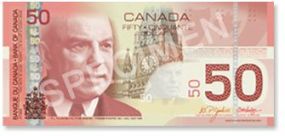



Canadian Bills (Bank Notes)
All 1986 and 2001 series bills measure 152.4 mm by 69.85 mm (6 by 2¾ inches).| 1986 ("Birds of Canada") series | |||
| Value | Colour | Obverse | Reverse |
| $2‡ | Terra cotta | Queen Elizabeth II | American robins |
| $5‡ | Blue | Wilfrid Laurier | Belted kingfisher |
| $10‡ | Purple | John A. Macdonald | Osprey |
| $20 | Green | Queen Elizabeth II | Common loon |
| $50 | Red | William Lyon Mackenzie King | Snowy owl |
| $100 | Brown | Robert Borden | Canada goose |
| $1000‡ | Reddish purple | Queen Elizabeth II | Pine grosbeak |
‡ Withdrawn from circulation. Currency withdrawn from circulation is still legal tender. As of early 2005, the 1986-series $5 and $10 bills are still occasionally encountered, but they are rapidly disappearing from regular use. $1,000 bills are no longer printed, but are still used by banks and casinos occasionally.
| 2001 ("Canadian Journey" series) | |||
| Value | Colour | Obverse | Reverse |
| $5 | Blue | Wilfrid Laurier | Children playing hockey and other winter
sports; excerpt from "The Hockey Sweater" by Roch Carrier |
| $10 | Purple | John A. Macdonald | Peacekeeping forces and war memorial;
excerpt from "In Flanders Fields" by John McCrae |
| $20 | Green | Queen Elizabeth II | Artwork of Bill Reid; excerpt from
Gabrielle Roy's novel, The Hidden Mountain. |
| $50 | Red | William Lyon Mackenzie King | The Famous Five and Thérèse Casgrain; quotation from the Universal Declaration of Human Rights |
| $100 | Brown | Robert Borden | Maps of Canada, historic and modern; excerpt from Miriam Waddington's poem, "Jacques Cartier in Toronto" |

Issuance of Canada's new Polymer Bank Notes - 2011 to 2013
The themes, designs, images and security features for the entire series of Canada's new polymer bank notes were unveiled from 2011 to 2013. The Bank of Canada has now replaced all paper bank notes with the new polymer bank notes.The new bills are equipped with several security features that make it very difficult to counterfeit, according to a Bank of Canada press release . A transparent maple leaf and a clear portion on the left side of the bill with holographs that change color in the light are designed to foil counterfeiters attempting to create fake notes. There are many additional security features on the various bills.


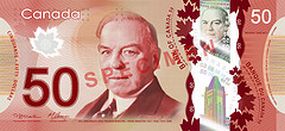

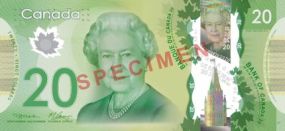
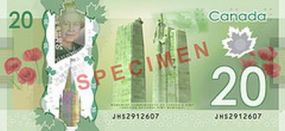

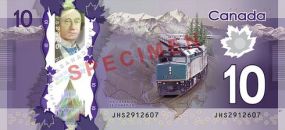
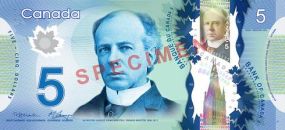


Canada’s New Polymer Notes
Canada’s new bank notes evoke the country’s spirit of innovation. The new Polymer series is itself a technical innovation, and its designs celebrate Canada’s achievements at home, around the world and in space. Reflecting the ingenuity, determination and courage of a nation and its people, Canada’s accomplishments extend well past our frontiers.
$100 Note - Design Features
Portrait: Sir Robert L. Borden, Prime Minister, 1911–20
Building: The East Block of Parliament
Signatures: Left – T. Macklem, Right – M.J. Carney
Size: 152.4 x 69.85 mm (6.0 x 2.75 inches)
Issue Date: 14 November 2011
Theme: Medical Innovation
Canadians have long been at the frontiers of medical research and as a result have helped to save millions of lives worldwide. Notable Canadian contributions include pioneering the use of insulin to treat diabetes, DNA and genetic research, the invention of the pacemaker, and the first hospital-to-hospital robot-assisted surgery.
$50 Note - Design Features
Portrait: William Lyon Mackenzie King, Prime Minister, 1921–30 and 1935–48
Building: The Centre Block of Parliament
Signatures: Left – T. Macklem, Right – M.J. Carney
Size: 152.4 x 69.85 mm (6.0 x 2.75 inches)
Issue date: 26 March 2012
Theme: CCGS Amundsen, Research Icebreaker
The vastness and splendour of Canada’s northern frontier have helped to shape our cultural identity. The icebreaker plays an important role in the North, keeping Canada’s historic passages open, undertaking marine search and rescue, supporting isolated communities, and participating in international environmental research. The CCGS Amundsen helps Canada—the nation with the world’s longest stretch of Arctic coastline—to remain at the leading edge of Arctic research, providing the world’s oceanographers, geologists and ecologists with unparalleled access to the North.
$20 Note - Design Features
Portrait: Her Majesty Queen Elizabeth II
Building: The Peace Tower
Signatures: Left – T. Macklem, Right – M.J. Carney
Size: 152.4 x 69.85 mm (6.0 x 2.75 inches)
Issue date: 7 November 2012
Theme: Canadian National Vimy Memorial
The Canadian National Vimy Memorial is featured on the new $20 note as a tribute to Canada’s contributions and sacrifices in military conflicts throughout its history. Located on the site of the 1917 Battle of Vimy Ridge, the Canadian National Vimy Memorial in France was erected in honour of Canadian service during the First World War.
$10 Note - Design Features
Portrait: Sir John A. Macdonald, Prime Minister, 1867-1873 and 1878-1891
Building: The Library of Parliament
Signatures: Left - T. Macklem, Right - M.J. Carney
Size: 152.4 x 69.85 mm (6.0 x 2.75 inches)
Issue Date: November 2013
Theme: The Canadian train
The expansion of the railway in the 1880s was hailed as a remarkable feat of engineering for a young country with a varied and often treacherous terrain. At the time, the railway was the longest ever built, and its completion demonstrated Canada’s pioneering spirit by linking our eastern and western frontiers, connecting people, and facilitating the exchange of goods. Today, The Canadian train, winding its way through the Rockies showcases Canada’s natural beauty and symbolizes what we accomplished as a young nation.
$5 Note - Design Features
Portrait: Sir Wilfrid Laurier, Prime Minister, 1896–1911
Building: The West Block of Parliament
Signatures: Left - T. Macklem, Right - M.J. Carney
Size: 152.4 x 69.85 mm (6.0 x 2.75 inches)
Issue Date: November 2013
Theme: Canadarm2 and Dextre
Robotics innovation is Canada’s ongoing contribution to the International Space Station program and demonstrates our commitment to space exploration. The Canadian-built Mobile Servicing System is the sophisticated robotics suite that helped to assemble the International Space Station in orbit. This system consists of Canadarm2, Dextre and the Mobile Base.
On board the space station - a permanent orbiting research laboratory - international partners conduct scientific experiments, many of which result in an enhanced quality of life on earth. Canada’s contribution to the space program evokes pride and sparks the imagination and curiosity of our future leaders in science and technology.

Commemorative $20 Note - Queen Elizabeth's Reign


September 9, 2015, the Bank of Canada introduced a new 20-dollar polymer banknote to commemorate Her Majesty Queen Elizabeth II on becoming the longest-reigning sovereign in Canada’s modern era. The new note is identical to the current $20 note, with one distinct difference: its large window contains a range of special design elements, including a portrait of Her Majesty wearing a crown (tiara) for the first time on a Canadian bank note. The portrait is based on a 1951 image by renowned Canadian photographer Yousuf Karsh – the same photograph that inspired the portrait engraving of the Queen, without the crown, for the 1954 Canadian Landscape series of bank notes and the 1967 commemorative $1 note celebrating Confederation. Since her accession to the throne in 1952, an image of Her Majesty has appeared on every series of Canadian bank notes.

Commemorative $10 Note - Canada's 150th Birthday


The Bank of Canada has unveiled its latest commemorative note ahead of the nation’s sesquicentennial anniversary (150th anniversary of Confederation).
The front of the commemorative 150 note includes portraits of:
- Sir George-Étienne Cartier - one of the fathers of Confederation
- Sir John A Macdonald - Canada’s first Prime Minister
- Agnes Macphail – the first woman to be elected to Canadian parliament
- James Gladstone – Canada’s first First Nations senator
The note’s front also carries images of Parliament’s Hall of Honour, the names of all the provinces and territories and a depiction of the Memorial Chamber Arch in the Peace Tower of Parliament’s centre block.
On the back, the note showcases five different landscapes representing the various regions of Canada:
- the Lions/Twin Sisters (Western Canada)
- a wheat field (Prairie provinces)
- the Canadian Shield (Central Canada)
- Cape Bonavista (Eastern Canada)
- the Northern lights (Northern Canada).
The commemorative $10 note also has new security features, including a colour-shifting arch, as well as three-dimensional maple leaves.
The Canada 150 notes was released into circulation on June 1st 2017 in an attempt to have the bills readily available at financial institutions ahead of Canada Day. It will be a commemorative one and won’t replace the existing design. This is only the fourth commemorative bank note the Bank of Canada has issued in its 82 year history. There will be 40 million special $10 bills available, one for every Canadian.

New Vertical $10 Note - Viola Desmond

Viola Desmond was a successful black businesswoman who was jailed, convicted and fined for defiantly refusing to leave a whites-only area of a movie theatre in 1946. Her court case was an inspiration for the pursuit of racial equality across Canada. Viola’s story is part of the permanent collection at the Canadian Museum for Human Rights.
Desmond is the first black person - and the first non-royal woman - on a regularly circulating Canadian bank note.
Released on International Women's Day March 8, 2018
Design Features included in this note:
- Canada's first 'vertical format' note
- Map of the historical North-End of Halifax
- Vaulted dome of the Library of Parliament
- The Canadian Flag
- Coat of Arms of Canada
- The Maple leaf appears on both sides - another well known Canadian image
- Window of the Canadian Museum of Human Rights in Winnipeg
- Quote from the Canadian Charter of Human Rights and Freedoms
- Series of criss-crossing ramps that connect to the 7 levels of the Museum
- A feather to sympolize Truth, Power and Freedom
- A laurel leaf - the symbol of Justice

Site © by K.C.I.C. - A. Knight (Webmaster)
Please visit our other pages